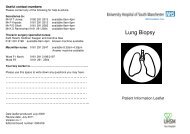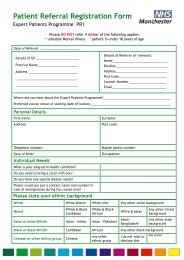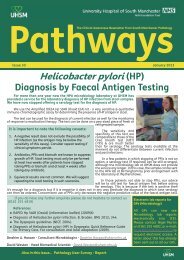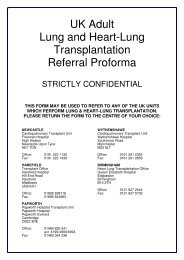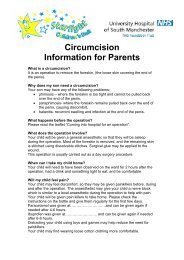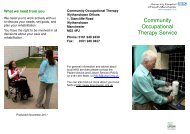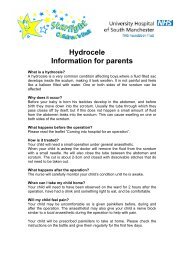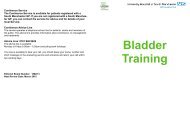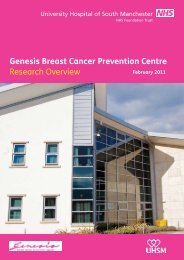Drug Allergy – the facts - Anaphylaxis Campaign
Drug Allergy – the facts - Anaphylaxis Campaign
Drug Allergy – the facts - Anaphylaxis Campaign
Create successful ePaper yourself
Turn your PDF publications into a flip-book with our unique Google optimized e-Paper software.
thus induced. Insulin-induced anaphylaxis may be more common in patients whose treatment is interrupted<br />
or intermittent; this may apply more generally to o<strong>the</strong>r drugs too.<br />
Antibiotics<br />
These drugs, which include penicillin, are commonly used for treating infection. <strong>Allergy</strong> is sometimes blamed<br />
for symptoms <strong>the</strong>y are thought to cause, but this is not always <strong>the</strong> case.<br />
Infrequently, people allergic to one antibiotic may react to ano<strong>the</strong>r within <strong>the</strong> same ‘family’ of antibiotics (this<br />
is known as cross-reactivity). For this reason, a doctor should be consulted to discuss whe<strong>the</strong>r drugs in <strong>the</strong><br />
same family should be avoided.<br />
Diagnosis of penicillin allergy<br />
Penicillin allergy is a genuine problem, but <strong>the</strong> disease for which <strong>the</strong> penicillin has been administered may<br />
also cause allergy-like symptoms. This frequently leads to false diagnoses of penicillin allergy.<br />
For example, a delayed rash following ampicillin or amoxycillin in <strong>the</strong> context of a childhood illness is<br />
common and almost always does not suggest an underlying penicillin allergy. But if <strong>the</strong> rash is immediate, or<br />
if <strong>the</strong>re is nettle rash, or if <strong>the</strong>re are o<strong>the</strong>r symptoms such as facial swelling, itching or even anaphylaxis, <strong>the</strong><br />
doctor may decide testing is necessary. The person can be referred to an NHS allergy clinic, where skin prick<br />
testing (and occasionally intradermal skin testing) can be carried out, if appropriate; this is generally more<br />
helpful than blood tests.<br />
The label ‘allergic to penicillin’ should not be applied lightly. Many people, wrongly deemed ‘allergic to<br />
penicillin’ in childhood, are unnecessarily denied a safe and useful treatment, as doctors are reluctant to<br />
administer penicillin and related antibiotics to those who say <strong>the</strong>y are allergic.<br />
The best advice is to discuss any symptoms with your doctor. And if you are one of those people labelled<br />
‘allergic to penicillin’ since childhood, it is useful to try to find out why this label was applied. Medical records<br />
may hold <strong>the</strong> answer. It would be helpful to know which penicillin is thought to have caused <strong>the</strong> reaction.<br />
The o<strong>the</strong>r aspect to this problem is that <strong>the</strong> concept of penicillin allergy becomes devalued by its<br />
inappropriate use, so that patients genuinely in danger of a severe reaction may be given this antibiotic.<br />
Rashes after administration of antibiotics<br />
Rashes occur occasionally during <strong>the</strong> course of antibiotic treatment, but <strong>the</strong>se are not always signs of allergy<br />
to <strong>the</strong> antibiotic. The illness being treated (e.g. scarlatina) may be <strong>the</strong> cause of <strong>the</strong> rash. In o<strong>the</strong>rs, <strong>the</strong> disease<br />
in conjunction with <strong>the</strong> antibiotic, as with ampicillin and glandular fever, may cause <strong>the</strong> problem, <strong>the</strong><br />
antibiotic being well tolerated if taken again for some o<strong>the</strong>r reason.<br />
In assessing whe<strong>the</strong>r <strong>the</strong> symptoms are <strong>the</strong> result of genuine allergy, <strong>the</strong> nature and timing of <strong>the</strong> rash are<br />
important. The typical symptoms present during a genuine anaphylactic reaction to an antibiotic might be an<br />
urticarial rash (hives or nettle rash, with itchy weals), starting within a couple of hours of <strong>the</strong> first dose of a<br />
<strong>Drug</strong> <strong>Allergy</strong> Factsheet<br />
Document Reference ACFS3<br />
©The <strong>Anaphylaxis</strong> <strong>Campaign</strong> 2011 3






